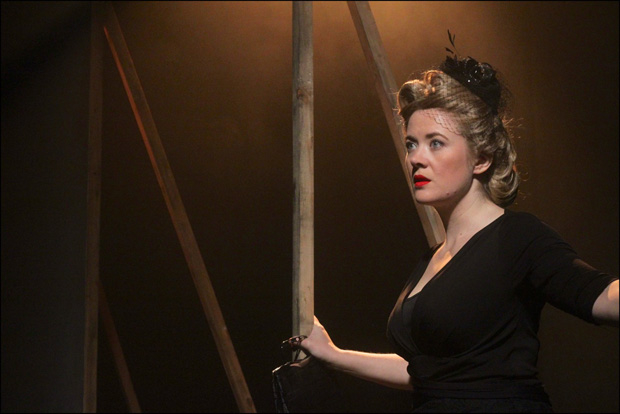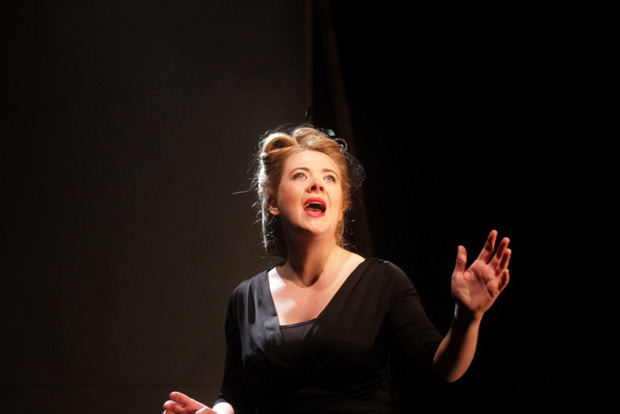The Girl Who Jumped Off the Hollywood Sign

(© Tom Kitney)
A woman really did jump off the Hollywood sign in 1932. Her name was Peg Entwistle. Following a successful career on Broadway, she decided to try her luck in Hollywood. Within a year of her arrival in L.A., she was dead in a ravine in the Hollywood Hills. This play isn't about her, but it is a fictional account of a woman who considers following in her footsteps. Written and performed by Joanne Hartstone, The Girl Who Jumped Off the Hollywood Sign at Theater for the New City is a heartbreaking look at the human cost of America's dream factory, a place that still considers young actresses raw material to be processed or discarded.
Hartstone plays Evie Edwards, a fresh-faced kid from a St. Louis Hooverville. Like a lot of Americans, her only escape from the misery of the Depression was the movie house. So when her father moves to Culver City to work for Howard Hughes during the war, she decides she's going to go with him and break into the biz. Obviously, things don't work out the way she plans, since she is telling us her life story while clutching the side of the giant Hollywood H. Evie has decided to take her life, and for 70 minutes she tells us why.

(© Tom Kitney)
It's not just that her career has failed to take flight, but the troubling realization that even the women who do make it big often pay a huge price. Evie recounts the gruesome story of Jean Harlow, who died at the age of 26 of kidney failure, potentially accelerated by her use of toxic chemicals to achieve her signature shade of platinum blond. Harlow's death is still the subject of contention, but no one can deny that M.G.M. boss Louis B. Mayer turned her funeral into a public spectacle. "Even in death," Evie says darkly, "Jean Harlow made M.G.M. a lot of money."
Designer Tom Kitney adorns Hartstone in a dress that skirts the line between sexy and funereal: Evie tells us that it once belonged to silent film "vamp" Theda Bara, but we wonder if this is not just the pitch of an enterprising consignment salesman. Kitney (who also did the set and lighting) has actually created the top half of the H. Director Vince Fusco stages Hartstone on and around the supersized letter, allowing her to hop off for flashbacks (simple yet effective lighting makes this dimension shift clear). Even though he only has a few instruments at his disposal, Kitney is able to affect a convincing Technicolor look for Hartstone's musical numbers. She practically glows as she warbles "You Made Me Love You" and "But Not for Me" through her breathy, antique jazz vocals.
Some viewers may find Hartstone's gee-whiz girl-next-door delivery grating. Her sunny optimism turns on a dime to abject despair as she telegraphs every emotional beat for the back row. Certainly, her central casting interpretations of the people around her ensure that we always know who is speaking. This isn't bad acting, but a frighteningly real portrayal of a damaged person who is only able to express emotions in the manner dictated by M.G.M. She exhibits heightened femininity and exaggerated innocence, ever aware that no ugly crying will be tolerated. In her performance, Hartstone disturbingly showcases the power art can wield not just over our psyches, but our physical beings.

(© Tom Kitney)
The Hollywood megaphone is an especially loud purveyor of American art, as evidenced by Hartstone herself. In a program note, she reveals that she grew up idolizing Judy Garland and Marilyn Monroe, spending much of her free time watching recording of their movies from the comfort of her family home — in Adelaide, Australia. Although presented in an old-fashioned package, The Girl Who Jumped Off the Hollywood Sign is a timely call for responsibility on the part of our self-styled dream merchants when they still have a long way to go.










